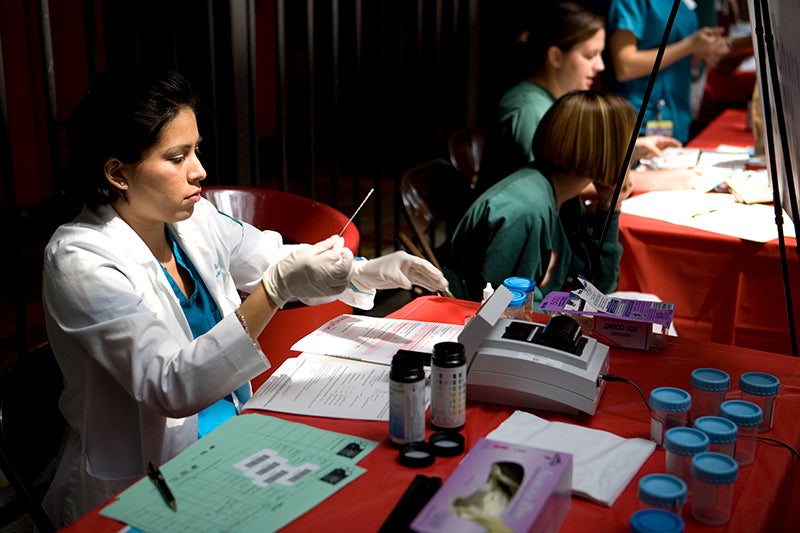CKD is a silent threat to employee wellness, productivity, and your bottom line. NKF can help.
What Employers Should Know About Kidney Disease
Chronic Kidney Disease (CKD) is a public health crisis impacting over 35.5 million US adults, but 90% are unaware and undiagnosed.
1 in 3 adults are at risk for CKD, including those with diabetes, hypertension or a family history of CKD.
Approximately 9% of people of working age (18-65) are affected by CKD, the majority in early stages.1
Cardiovascular events are the most common impacts of CKD. More people with CKD will experience cardiovascular mortality than kidney failure.2
CKD is generally asymptomatic and can progress for many years without being diagnosed, silently increasing health care utilization as the cardiovascular complications of CKD arise.
Financial Toll of CKD on Employers
CKD adds significantly to employer health care costs through higher health care utilization. CKD can account for 10% of annual health care costs for employers, due to with low testing, limited diagnosis, and minimal management.4
It is estimated that 44% of the diabetes population has CKD.5 Individuals with CKD and type 2 diabetes (the most common cause of CKD) have annual costs nearly double those of individuals with type 2 diabetes alone.4
Costs of CKD also increase rapidly as CKD progresses,4 there is urgency for employers to better manage this risk through early intervention.
Although Medicare eventually covers dialysis costs, employers may be responsible for costs for the first 30 months of treatment, an estimated $15,444 per month ($463,320 over 30 months).6
What Can Employers Do?
Early intervention and supportive policies are key. Prioritizing CKD screening, early treatment, and increasing access to kidney transplant or home dialysis can help employers contain rising health care costs, while improving workforce wellbeing.
References
- 1. United States Renal Data System. 2024 USRDS Annual Data Report: Epidemiology of kidney disease in the United States. National Institutes of Health, National Institute of Diabetes and Digestive and Kidney Diseases, Bethesda, MD: , 2024. (https://adr.usrds.org/2024).
- 2. van der Velde M, Matsushita K, Coresh J, et al. Lower estimated glomerular filtration rate and higher albuminuria are associated with all-cause and cardiovascular mortality. A collaborative meta-analysis of high-risk population cohorts. Kidney Int 2011;79(12):1341-52. (In eng). DOI: 10.1038/ki.2010.536.
- 3. Alfego D, Ennis J, Gillespie B, et al. Chronic Kidney Disease Testing Among At-Risk Adults in the U.S. Remains Low: Real-World Evidence From a National Laboratory Database. Diabetes Care 2021;44(9):2025-2032. (In eng). DOI: 10.2337/dc21-0723.
- 4. Chung H, Crowe CL, Kong SX, et al. Descriptive study of the economic burden among patients with type 2 diabetes mellitus, chronic kidney disease, and chronic kidney disease and type 2 diabetes mellitus in a large US commercially insured population. J Manag Care Spec Pharm 2023;29(1):80-89. (In eng). DOI: 10.18553/jmcp.2023.29.1.80.
- 5. KDIGO 2022 Clinical Practice Guideline for Diabetes Management in Chronic Kidney Disease. Kidney Int 2022;102(5s):S1-s127. (In eng). DOI: 10.1016/j.kint.2022.06.008.
- 6. League RJ, Eliason P, McDevitt RC, Roberts JW, Wong H. Variability in Prices Paid for Hemodialysis by Employer-Sponsored Insurance in the US From 2012 to 2019. JAMA Network Open 2022;5(2):e220562-e220562. DOI: 10.1001/jamanetworkopen.2022.0562.
- 7. Alma MA, van der Mei SF, Brouwer S, et al. Sustained employment, work disability and work functioning in CKD patients: a cross-sectional survey study. J Nephrol 2023;36(3):731-743. (In eng). DOI: 10.1007/s40620-022-01476-w.
- 8. Mercer. National Survey of Employer Sponsored Health Plans. (https://www.mercer.com/en-us/solutions/health-and-benefits/research/national-survey-of-employer-sponsored-health-plans/).
- 9. (OSG) OotSG. The Surgeon General’s Call to Action to Improve Maternal Health [Internet]. In: Services UDoHaH, ed. Washington (DC)2020.
- 10. Foundation OH. Employer Dental Insurance. (https://www.dentalhealth.org/employer-dental-insurance).



